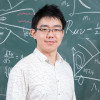セミナー
784 イベント
-
セミナー
Geometric decomposition of entropy production in stochastic and chemical systems
2022年12月16日(金) 13:30 - 15:00
吉村 耕平 (東京大学 大学院理学系研究科 物理学専攻 博士課程)
Entropy production is central to understanding nonequilibrium phenomena. It is known that decomposing entropy production enables us to separately treat distinct two aspects of dynamics, nonstationarity and breaking of detailed balance. In this seminar, I talk about our recent progress on geometric decomposition of entropy production in discrete stochastic systems and deterministic chemical systems. For the audience who may not be familiar with nonequilibrium thermodynamics and linear algebraic graph theory, which the latter enables us to treat the two kinds of systems at once, I would like to start with a very basic introduction. Then I explain why and how we decompose entropy production. Specifically, I mainly focus on the "Onsager-projective decomposition" we study in arXiv:2205.15227 rather than the information geometric decomposition provided in the following paper arXiv:2206.14599. Further, several physical consequences will be discussed, including generalization of Schnakenberg's decomposition stemming from cycles in a steady system, and its relation to gradient flow expressions of a master equation and a rate equation.
会場: via Zoom
イベント公式言語: 英語
-
セミナー
Chemophoresis Engine: Theory of ATPase-driven Cargo Transport
2022年12月15日(木) 16:00 - 17:00
菅原 武志 (東京大学 生物普遍性研究機構 特任研究員)
The formation of macromolecule patterns depending on chemical concentration under non-equilibrium conditions, first observed during morphogenesis, has recently been observed at the intracellular level, and its relevance as intracellular morphogen has been demonstrated in the case of bacterial cell division. These studies have discussed how cargos maintain positional information provided by chemical gradients. However, how cargo transports are directly mediated by chemical gradients remains unknown. Based on the previously proposed mechanism of chemotaxis-like behavior of cargos (referred to as chemophoresis), we introduce the chemophoresis engine as a physicochemical mechanism of cargo motion, which transforms chemical free energy to directed motion through the catalytic ATP hydrolysis [1]. We propose its possible role as a universal principle of hydrolysis-driven intracellular transport.
会場: via Zoom
イベント公式言語: 英語
-
セミナー
Lattice gauge theory in curved spacetimes
2022年12月15日(木) 14:00 - 15:30
山本 新 (東京大学 大学院理学系研究科 物理学専攻 助教)
Lattice gauge theory is a powerful computational approach in quantum field theory. It is also utilizable for investigating quantum phenomena in curved spacetimes, such as rotating frame, torsion, and gravitational backgrounds. In this talk, I would like to overview the formulation and results of lattice simulations in curved spacetimes.
会場: コモンルーム (246-248号室) (メイン会場) / via Zoom
イベント公式言語: 英語
-
セミナー
Chiral effects on lepton transport in core-collapse supernovae
2022年12月13日(火) 13:30 - 15:00
Di-Lun Yang (Assistant Research Fellow, Institute of Physics, Academia Sinica, Taiwan)
Dynamics of leptons such as electrons and neutrinos play an important role in the evolution of core-collapse supernovae (CCSN). Nevertheless, chirality as one of fundamental microscopic properties that could affect lepton transport, through e.g. weak interaction, has been mostly overlooked. In this talk, I will discuss how chiral effects such as the renowned chiral magnetic effect (CME), generating an electric charge current along magnetic fields with chirality imbalance, could result in the unstable modes of magnetic fields and inverse cascade, which potentially influence the matter evolution in CCSN and pulsar kicks. I will also show how an effective CME could be realized via the backreaction from neutrino radiation even in the absence of an axial charge characterizing an unequal number of right- and left-handed electrons.
会場: コモンルーム 246-248号室 とZoomのハイブリッド開催
イベント公式言語: 英語
-
セミナー
Quantum kinetics of neutrinos in high-energy astrophysical phenomena
2022年12月9日(金) 14:00 - 15:00
長倉 洋樹 (国立天文台 科学研究部 特任助教(国立天文台フェロー))
Neutrinos are the most mysterious and elusive particles in the standard model of particle physics. They play important roles in core-collapse supernovae and binary neutron star mergers as driving mass-ejection, synthesizing heavy elements including r-process nuclei, and neutrino signals from these sources. This exhibits the importance of accurate modeling of neutrino radiation field in these phenomena, which will be used to connect neutrino physics to multi-messenger astronomy. It has recently been suggested that neutrino-flavor conversion (or neutrino-oscillation) can ubiquitously occur in these astrophysical environments, exhibiting the requirement of quantum kinetic treatments in the modeling of neutrino transport. In this seminar, I will give an overview of the quantum kinetics neutrino transport and then introduce its recent progress, paying a special attention to the connection to astrophysics. I will also present the latest results of our numerical simulations of collective neutrino oscillations, which can be properly accounted for only by quantum kinetic framework.
会場: via Zoom
イベント公式言語: 英語
-
セミナー

Carrollian hydrodynamics near the black hole horizon
2022年12月8日(木) 16:00 - 17:30
プトゥラク・ジャイアクソナ (理化学研究所 数理創造プログラム (iTHEMS) 特別研究員)
The membrane paradigm provides a fascinating bridge between gravitational dynamics near black hole horizons (null boundaries) and fluid dynamics. One question naturally follows: what type of fluids and hydrodynamics emerged at the horizon? Contrary to the longstanding belief, it turns out that the horizon fluid is Carrollian, rather than the Galilean (Navier-Stokes) fluid. The Carroll geometries and Carrollian physics, arising originally when the speed of light goes to zero (c to 0 limit), have recently gained increasing attention in the fields of black hole physics and flat holography. In this presentation, I will talk about the Carrollian limit and the resulting Carroll geometries and this unusual kind of hydrodynamics, the Carrollian hydrodynamics. I will then present the geometrical construction of the membrane (also known as the stretched horizon) in a way that a Carroll geometry manifest, therefore allowing us to spell out precisely the dictionary between gravitational degrees of freedom on the membrane and the Carrollian fluid quantities. I will also show that the Einstein’s equations projected onto the horizon are the Carrollian hydrodynamic conservation laws. Lastly, I will discuss the covariant phase space of the horizon, symmetries, and conservation laws. The talk is based on arXiv:2209.03328 and arXiv:2211.06415.
会場: コモンルーム 246-248号室 とZoomのハイブリッド開催
イベント公式言語: 英語
-
セミナー
Cosmic Birefringence: how our universe violates left-right symmetry
2022年12月6日(火) 13:30 - 15:00
藤田 智弘 (早稲田大学 高等研究所 講師)
Our universe is lefty: recent observations imply that the polarization plane of light that has traveled through cosmic space for 13.8 billion years rotates about 0.3 degrees to the left. A similar phenomenon is known to occur in materials such as crystals, and is called birefringence. But why does birefringence occur even in the outer space, which is supposed to be a vacuum? Dark energy, the unknown energy that fills the universe, may be responsible for it. In this seminar, I will review observations and theories of cosmic birefringence and discuss future prospects.
会場: コモンルーム 246-248号室 とZoomのハイブリッド開催
イベント公式言語: 英語
-
セミナー

Efficient encoding of the Schrodinger equation on quantum computers
2022年12月5日(月) 14:00 - 15:30
エルマル・ルラーバイ (理化学研究所 数理創造プログラム (iTHEMS) 特別研究員)
The continuous space Schrödinger equation is reformulated in terms of spin Hamiltonians. For the kinetic energy operator, the critical concept facilitating the reduction in model complexity is the idea of position encoding. A binary encoding of position produces a spin-1/2 Heisenberg-like model and yields exponential improvement in space complexity when compared to classical computing. Encoding with a binary reflected Gray code (BRGC), and a Hamming distance 2 Gray code (H2GC) reduces the model complexity down to the XZ and transverse Ising model respectively. Any real potential is mapped to a series of k-local Ising models through the fast Walsh transform. As a first step, the encoded Hamiltonian is simulated for quantum adiabatic evolution. As a second step, the time evolution is discretized, resulting in a quantum circuit with a gate cost that is better than the Quantum Fourier transform. Finally, a simple application on an ion-based quantum computer is provided as proof of concept.
会場: コモンルーム (246-248号室) (メイン会場) / via Zoom
イベント公式言語: 英語
-
セミナー
Tricritical phenomena in holographic chiral transitions
2022年11月29日(火) 13:30 - 15:00
松本 匡貴 (Postdoctoral Researcher, Department of Physics, Shanghai University, China)
Tricritical point (TCP) is the end-point of a line of three-phase coexistence (a triple line) at which three coexisting phases simultaneously become identical. A TCP can be observed in various systems, for example, the QCD phase diagram with the chiral limit and a metamagnet such as a FeCl2 crystal. In the AdS/CFT correspondence, a TCP associated with a chiral phase transition has been found in the D3/D7 model [1]. In this talk, I will discuss the recent study [2] of critical phenomena at a tricritical point which emerges in the D3/D7 model in the presence of a finite baryon number density and an external magnetic field. We found all the critical exponents defined in this paper take the mean-field values. I will also compare the results with our previous works about the critical phenomena at the TCP that emerges in the steady state [3,4].
会場: コモンルーム 246-248号室 とZoomのハイブリッド開催
イベント公式言語: 英語
-
セミナー
Community assembly and species coexistence in the heterogeneous world
2022年11月28日(月) 16:00 - 17:00
篠原 直登 (東北大学 大学院生命科学研究科 助教)
How ecological communities are assembled and maintained is a fundamental question in community ecology. To tackle this challenge in the heterogeneous world, we need to understand how community assembly patterns change with environmental gradients and how species coexist in temporally fluctuating environments. In the first of my talk, I introduce our study on how plant community assembly patterns change along with the largest global environmental gradient, the latitudinal gradient. Then, I will present how the seasonal variability of environments contributes to the coexistence of phytoplankton species in a lake. These results altogether uncover how spatiotemporal heterogeneity of environments forms ecological communities in nature.
会場: コモンルーム 246-248号室 とZoomのハイブリッド開催
イベント公式言語: 英語
-
セミナー
Tropical methods in Enumerative Geometry and Mirror Symmetry
2022年11月25日(金) 14:00 - 16:00
Michel Van Garrel (Assistant Professor, School of Mathematics, University of Birmingham, UK)
Abstract for the 1st hour: Enumerative Geometry has been a feature of mathematics from its beginnings, just think about the number of lines in the plane passing through 2 points. I will take you on a history of the subject and its relationship to other areas of mathematics and physics. Abstract for the 2nd hour: Many problems in mathematics are solved by taking a limit and solving the limiting problem. Tropical geometry is a key technique that allows us to do this systematically. I will talk about the following problem. Take the complex projective plane S and an elliptic curve E in S. Count algebraic maps from the affine line into the complement S \ E. This counting problem is solved via tropical geometry as I will describe in this talk.
会場: コモンルーム 246-248号室 とZoomのハイブリッド開催
イベント公式言語: 英語
-
セミナー

RNA-Puzzles - the evaluation and automation of RNA 3D structure
2022年11月24日(木) 16:00 - 17:00
Zhichao (Chichau) Miao (Principal Investigator, Guangzhou Laboratory, China / Guangzhou Medical University, China)
RNA-Puzzles is a collective endeavour dedicated to the advancement and improvement of RNA 3D structure prediction. With agreement from crystallographers, the RNA structures are predicted by various groups before the publication of the crystal structures. Systematic protocols for comparing models and crystal structures are described and analyzed. In RNA-Puzzles, we discuss a) the capabilities and limitations of current methods of 3D RNA structure based on sequences; b) the progress in RNA structure prediction; c) the possible bottlenecks that hold back the field; d) the comparison between the automated web server and human experts; e) the prediction rules, such as coaxial stacking; f) the prediction of structural details and ligand binding; g) the development of novel prediction methods; and h) the potential improvements to be made. Till now, 37 RNAs with crystal structures have been predicted, while many of them have achieved high accuracy in comparison with the crystal structures. We have summarized part of our results in three papers and two community-wide meetings. With the results in RNA-Puzzles, we illustrate that the current bottlenecks in the field may lie in the prediction of non-Watson-Crick interactions and the reconstruction of the global topology. Correct coaxial stacking and tertiary contacts are key for the prediction of RNA architecture, while ligand binding modes can only be predicted with low resolution. For the model evaluation, we present RNA-Puzzles toolkit, a computational resource including (i) decoy sets generated by different RNA 3D structure prediction methods, (ii) 3D structure normalization, analysis, manipulation, visualization tools and (iii) 3D structure comparison metric tools. With the increasing number of RNA structures being solved as well as the high-throughput biochemical experiments, RNA 3D structure prediction is becoming routine and accurate. Structure modelling may effectively help in understanding the viral RNA structures, including the SARS-CoV-2.
会場: via Zoom
イベント公式言語: 英語
-
セミナー
Energy partition in Weibel-mediated shock waves: from Supernova Remnants to Gamma-Ray Bursts
2022年11月24日(木) 14:00 - 15:00
Arno Vanthieghem (Princeton-NINS Postdoctoral Research Fellow, Department of Astrophysical Sciences, Princeton University, USA)
Gamma-ray bursts and supernovae provide ideal environments for efficient energy channeling between different plasma species through collective processes such as collisionless shock waves. Extensively studied in astrophysical and laboratory environments, observations and kinetic simulations indicate strong electron heating in the precursor of collisionless shock waves propagating in unmagnetized electron-ion plasmas. We outline a theoretical model accounting for electron heating via a Joule-like process through the interplay between pitch-angle scattering in the microturbulence and the coherent electrostatic field induced by the difference in inertia between species. Using analytical kinetic estimates, semi-analytical Monte Carlo methods, and ab-initio Particle-In-Cell simulations, we demonstrate the validity of this model in the relativistic regime relevant to the afterglow emission of gamma-ray burst and extend it to characterize the electron-to-ion-temperature ratio in the downstream of nonrelativistic high-Mach numbers shock waves relevant for supernova remnants and laboratory experiments.
会場: via Zoom
イベント公式言語: 英語
-
セミナー
Tetra and pentaquarks with multi-flavor contents
2022年11月22日(火) 13:30 - 15:00
保坂 淳 (大阪大学 核物理研究センター 教授)
Recent hadron experiments keep providing evidences of exotic hadrons with multi-quark components. These multiquarks are self-arranged into various configurations such as diquarks, hadronic molecules and so on. In this seminar, we discuss possible structures of tetra and pentaquarks with multi-flavor contents including recently observed T_cc, Pc and P_cs. Based on our recent studies in the quark model and hadron models, we discuss where and how different quark structures emerge.
会場: コモンルーム 246-248号室 とZoomのハイブリッド開催
イベント公式言語: 英語
-
セミナー
Mathematics of Post-Quantum Cryptography
2022年11月18日(金) 14:00 - 16:30
相川 勇輔 (三菱電機株式会社 情報技術総合研究所 研究員)
Cryptography keeps our everyday information communications secure. Cryptography based on key sharing have been used mainly for military purposes since ancient times in human history, but with the advent of the Internet, cryptography that does not require key sharing has become necessary. In 1976, Diffie and Hellman proposed the concept of public key cryptography, which does not require key sharing among communicators. Since then, research on public key cryptography has progressed, involving not only computer science but also mathematics, and has become an essential technology for the society we live in. The security of public key cryptography is supported by computational hardness of problems derived from mathematics. For example, the integer factoring problem is a basis for the security of RSA cryptography, and the discrete logarithm problem is for elliptic curve cryptography. However, in 1994, Shor proposed an efficient quantum algorithm that solves these problems. This means that emergence of large-scale quantum computers will break RSA and elliptic curve cryptography we use today. For this reason, research on next-generation cryptography, so-called Post-Quantum Cryptography (PQC for short), is currently underway to prepare for a future in which quantum computers will emerge. In this talk, without assuming any knowledge of cryptography, I will give a brief overview of cryptography and the progress of PQC. The first half of the talk will mainly outline the relationship between mathematics and cryptography, while the second half will discuss isogeny-based cryptography, one of the promising PQC, with our recent results.
会場: コモンルーム 246-248号室 とZoomのハイブリッド開催
イベント公式言語: 英語
-
セミナー
Emergence of growth and dormancy from a kinetic model of the Escherichia coli central carbon metabolism
2022年11月17日(木) 18:00 - 19:00
姫岡 優介 (東京大学 生物普遍性研究機構 助教)
Physiological states of bacterial cells exhibit a wide spectrum of timescale. Under nutrient-rich conditions, most of the cells in an isogenic bacterial population grow at certain rates, while a small subpopulation sometimes stays in a dormant state where the growth rates slow down by orders of magnitude. For revealing the origins of such heterogeneity of timescales, we studied the kinetic model of Escherichia coli central carbon metabolism. We found that the model robustly exhibits both the growing- and the dormant state. Performing the model reduction, we have revealed the necessary conditions for the distinct behaviour, namely, the depletion of energy due to the futile cycle and its non-uniform impact on the kinetics because of the coexistence of the energy currency-coupled and uncoupled reactions as well as branching of the network.
会場: via Zoom
イベント公式言語: 英語
-
セミナー

Merger and post-merger of binary neutron stars with a quark-hadron crossover equation of state
2022年11月15日(火) 15:00 - 17:01
黄 永嘉 (Ph.D. Student, University of Science and Technology of China, China)
The state of the ultra-dense matter remains one of the long-standing open questions. Neutron star (NS), as it cools down the eons ahead after the birth in the supernova explosion, provides an astrophysical laboratory to investigate the dense, strongly interacting nuclear matter at zero temperature. On the other hand, the most intense gravitational wave(GW) radiation is produced in regions of the strong gravitational field by coherent movements of masses with large compactness. Therefore, GW from binary neutron star(BNS) merger naturally contains the information from the ultra-dense matter. In this talk, I will introduce our recent work, "Merger and post-merger of binary neutron stars with a quark-hadron crossover equation of state ."Quark-hadron crossover(QHC) is one way of hadron-quark transition, which generally predicts a peak in sound speed vs. density, and so releases more pressure during the hadron-quark transition. I will first briefly summarize the features of QHC EOS and the BNS merger. I will then focus on how information on the hadron-quark transition shows in the GW and its spectrum during the BNS merger.
会場: via Zoom
イベント公式言語: 英語
-
セミナー
Expanding Edges of Quantum Hall Systems in a Cosmology Language - Hawking Radiation from de Sitter Horizon in Edge Modes
2022年11月11日(金) 16:00 - 17:30
堀田 昌寛 (東北大学 大学院理学研究科物理学専攻 助教)
Expanding edge experiments are promising to open new physics windows of quantum Hall systems. In a static edge, the edge excitation, which is described by free fields decoupled with the bulk dynamics, is gapless, and the dynamics preserve conformal symmetry. When the edge expands, such properties need not be preserved. We formulate a quantum field theory in 1+1 dimensional curved spacetimes to analyze the edge dynamics. We propose methods to address the following questions using edge waveforms from the expanding region: Does the conformal symmetry survive? Is the nonlinear interaction of the edge excitations induced by edge expansion? Do the edge excitations interact with the bulk excitations? We additionally show that the expanding edges can be regarded as expanding universe simulators of two-dimensional dilaton-gravity models, including the Jackiw-Teitelboim gravity model. As an application, we point out that our theoretical setup might simulate emission of analog Hawking radiation with the Gibbons-Hawking temperature from the future de Sitter horizon formed in the expanding edge region.
会場: 研究本館 3階 345−347号室 (メイン会場) / via Zoom
イベント公式言語: 英語
-
セミナー
Arithmetic dynamics on algebraic varieties
2022年11月11日(金) 14:00 - 16:30
松澤 陽介 (大阪公立大学 大学院理学研究科 数学専攻 准教授)
The study of self-maps of algebraic varieties is a relatively new and active area in mathematics. Such a self-map can be considered as a discrete dynamical system, and we can study the asymptotic properties of such systems from various points of views, including number theoretic viewpoint. I will introduce several problems in arithmetic dynamics and some of my results in this area.
会場: コモンルーム 246-248号室 とZoomのハイブリッド開催
イベント公式言語: 英語
-
セミナー
Sociogenesis: motivations and first steps
2022年11月10日(木) 16:00 - 17:00
Cédric Ho Thanh (理化学研究所 開拓研究本部 (CPR) 三好予測科学研究室 特別研究員)
Sociogenesis is a project that aims to study emergent social behaviors of multi-agent systems. In its simplest form, and agent simply seeks to survive by consuming food and maximizing some happiness score. In this presentation, I will discuss some motivations and inspirations of this project, as well as the challenges to get an agent to survive on its own. I will then showcase some methods to evaluate the quality of agents and their underlying architecture beyond simply looking at their lifespan. I will then conclude with some potential applications. No prior knowledge in reinforcement/deep learning is required to attend this presentation. This work is still mostly at an exploratory stage, so discussions and inputs from the audience are more than welcome!
会場: via Zoom
イベント公式言語: 英語
784 イベント
イベント
カテゴリ
シリーズ
- iTHEMSコロキウム
- MACSコロキウム
- iTHEMSセミナー
- iTHEMS数学セミナー
- Dark Matter WGセミナー
- iTHEMS生物学セミナー
- 理論物理学セミナー
- 情報理論セミナー
- Quantum Matterセミナー
- ABBL-iTHEMSジョイントアストロセミナー
- Math-Physセミナー
- Quantum Gravity Gatherings
- RIKEN Quantumセミナー
- Quantum Computation SGセミナー
- Asymptotics in Astrophysics セミナー
- NEW WGセミナー
- GW-EOS WGセミナー
- DEEP-INセミナー
- ComSHeL Seminar
- Lab-Theory Standing Talks
- 場の量子論セミナー
- Quantum Foundation セミナー
- STAMPセミナー
- QuCoInセミナー
- 産学連携数理レクチャー
- Number Theory Seminar
- Berkeley-iTHEMSセミナー
- iTHEMS-仁科センター中間子科学研究室ジョイントセミナー
- RIKEN Quantumレクチャー
- 作用素環論
- iTHEMS集中講義-Evolution of Cooperation
- 公開鍵暗号概論
- 結び目理論
- iTHES理論科学コロキウム
- SUURI-COOLセミナー
- iTHESセミナー
